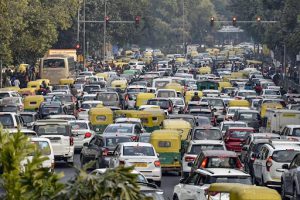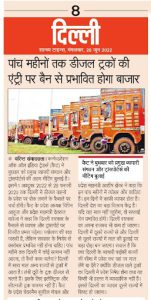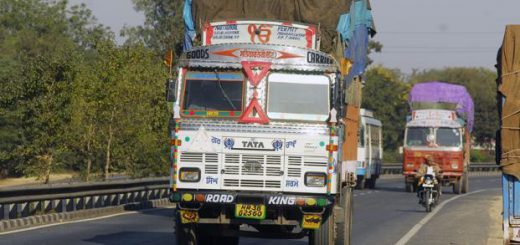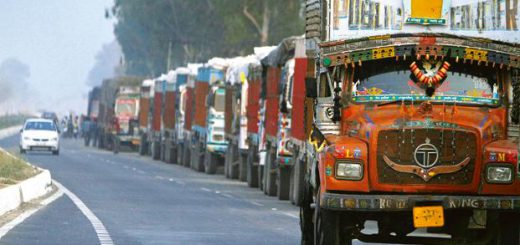Indian Trucking Industry : June Review
Indian Trucking Industry : June Review
The trucking industry is the lifeblood of the Indian economy. According to statistics, 90% of passenger traffic and 60% of freight moves on Indian roadways. Trucks are the most commonly used means of freight transportation. According to the most recent research from IMARC Group, the Indian truck market was worth US$ 10,850 million in 2020 and is expected to increase at a CAGR of roughly 12% between 2021 and 2026.
Every month, the Government of India takes several measures to help the trucking industry grow and become more organized. Keeping up with the latest trucking news in India, on the other hand, is a challenging task. As a result, this blog will go through the most recent trucking industry updates in June.
-
Automated Fitness Test for Buses and Trucks
The Delhi Transport Department began an automated fitness test for buses and trucks earlier this month. According to a senior official, this move will help eliminate the need for human intervention.
The government also stated that it would soon seek bids for automated fitness testing for auto-rickshaws and other small vehicles.
An effort is being made to tackle the growing pollution in the capital city. The automated fitness test process is said to examine the engine’s health and other parameters that may be the source of pollution.
Let us have a look at how this works.
So, whenever a vehicle is brought in for a fitness test, a gadget checks the noise levels, and a probe is inserted to check the level of smoke emission. If the equipment detects excessive noise, it clearly shows that the car is in poor condition. According to authorities, the device will also be used to evaluate the vehicle’s centering. Other parameters, such as speed governors and headlights, will be tested as part of the test.
What happens following the fitness test?
After passing an automated fitness test, the vehicle will be granted an e-fitness certificate valid for a year.
For those unaware, the fitness testing procedure was previously outsourced to an agency. This necessitated a large number of manual employees and an appointment of a district transport officer to supervise the operation.
As a result, an automated system is being deployed to reduce the manual effort. The officer also stated that fitness assessments for auto-rickshaws and taxis are now done manually in Burari, with the government hoping to automate the process shortly.
Also Read: Trends in Indian trucking industry in 2022
-
Ban On Entry Trucks
The Delhi government recently announced a restriction on the entry of medium and heavy commercial vehicles into the city from October 1, 2022, to February 28, 2023.
The government has made this effort to reduce pollution this winter.
Even on June 15, the government wrote to neighboring states such as Haryana and Uttar Pradesh, requesting that only BS-VI compliant buses enter the city beginning October 1 to reduce pollution.
The government said that automobiles from nearby states such as Haryana and Uttar Pradesh contributed to the city’s rising automotive pollution. As a result, the Delhi government has sent a specific notice to neighboring states to collaborate and help tackle the situation.
The rising pollution in the capital city is a serious concern. Every year, beginning in October, the city experiences high levels of pollution owing to various factors such as stubble burning, firecrackers, and vehicular traffic.

Click here for image source
Also, in 2021, the Delhi government declared a complete ban on the use and sale of fireworks. The Delhi Pollution Control Committee had also prohibited the sale and usage of firecrackers until January 1, 2022, citing the risk of another COVID-19 outbreak and pollution.
Every year, as winter approaches, the air quality in the capital falls into the severe category. It is not the first time the government has prohibited or restricted car admission. To deal with the problem, the government has enacted many restrictions, including a prohibition on building and demolition operations, the closure of public schools, and a ban on truck entry.
According to various sources, 70,000-80,000 trucks enter Delhi each year.
The Delhi government, however, has not prohibited all commercial vehicles. CNG vehicles, e-trucks, and trucks transporting necessary supplies such as vegetables, fruits, eggs, milk, and tankers carrying petroleum products, will be permitted to enter the city.
Brijesh Goyal, Chairman of the Chamber of Trade and Industry (CTI), recently issued a statement saying that the government has issued no order prohibiting the entry of diesel vehicles beginning October 1.

However, the government’s move is not appreciated by truckers and commercial vehicle associations. They claim that the decision will hurt fleet owners who deal in heavy vehicles since they have to bear losses worth crores.
According to Rajendra Kapoor, president of the All India Motor and Goods Transport Association, prohibiting trucks from entering the city for 15-20 days is fair. However, four months is unreasonable and will negatively harm transporters.

“Businesses will be severely impacted. This will affect the government’s revenue and may result in price increases for food, vegetables, and other products, “he said.
The traders’ association CAIT said on Wednesday that it would launch a campaign on July 10 requesting that the Delhi government lift the five-month restriction on the entrance of medium and heavy commercial vehicles beginning in October. CAIT called a meeting of Delhi Trade Associations. The All India Transport Welfare Association and the Delhi Transport Association also attended the meeting.
During the meeting, the trade association further emphasized that if the government does not revoke this decision, Delhi’s traders would be forced to relocate to the bordering states of Haryana, Uttar Pradesh, and Rajasthan, for which the Delhi government will be held accountable.
What are your thoughts on this? Let us know in the comments section below. Also, keep following our blog for the most recent trucking industry news and updates. You can also connect with us on Linkedin.




Recent Comments